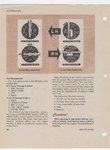Thank you for setting my numbers right, folks 
I'd stick the radiator in the front of the nacelle. That also saves weight for the cooling system. Add the saved weight from going on with classic layout, along with now lighter U/C that can be used means smaller and thinner wing can be used, for the same wing loading and better speed.
Better yet, stick the proper intercoolers in the nose, burry the radiators in the outer wing section, like at Airacuda.
Plenty of space in the fuselage for fuel now.
Problem for the P-38 in "classic" layout is that once you stick on the turbos and stick the radiators way back you have really long nacelles anyway. Please remember that they did sketch out many alternatives.
...
I'd stick the radiator in the front of the nacelle. That also saves weight for the cooling system. Add the saved weight from going on with classic layout, along with now lighter U/C that can be used means smaller and thinner wing can be used, for the same wing loading and better speed.
Better yet, stick the proper intercoolers in the nose, burry the radiators in the outer wing section, like at Airacuda.
Plenty of space in the fuselage for fuel now.

